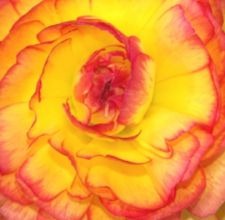The thickened underground structure at the stem base of bulbous plants is called a bulb, rhizome, tuber or corm, depending on the kind of plant. It provides a steady source of nutrients. Tuberous begonias grow from a disk-shaped corm about 2 inches wide with a thumb-sized depression in the top. Wax begonias, with small flowers and thick, shiny leaves, are called fibrous begonias; they don’t grow from corms.
Flowers
-
Tuberous begonias grow about 15 inches tall and produce large, ruffled flowers in a wide array of pink, yellow, white, red and orange tones. They are particularly valued for their ability to bloom in shade and are most often used in hanging baskets, window boxes and container plantings.
Planting
-
Plant begonia corms with their concave side up, just below the surface of a fast-draining potting soil. Begonias need temperatures above 70 degrees Fahrenheit to grow, so start them indoors under grow lights a month before last frost or outdoors once the weather has warmed.
Care
-
Begonias prefer dappled light or full shade. Water them regularly, but let the soil dry out between waterings. Frequent wetting of the leaves can encourage fungus diseases and mildew. Fertilize monthly during the growing season with a water-soluble fertilizer formulated for flowers.
Storage
-
In cold climates, move potted begonias indoors in October to overwinter in a basement or heated garage where temperatures don’t drop below 50 degrees Fahrenheit. Keep them dry and repot them in fresh soil in spring. Or dig up the corms, let them dry for two or three days and store them in peat moss or vermiculite.


Deprecated: strpos(): Passing null to parameter #1 ($haystack) of type string is deprecated in /home/agriviek8Qv/agriviet.net/public_html/wp-includes/comment-template.php on line 2522